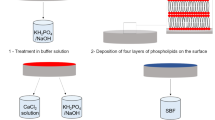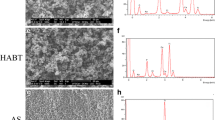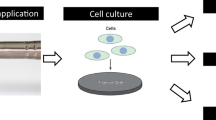Abstract
The purpose of this study was to evaluate the microscopic changes and surface roughness on hydroxyapatite (HA)-coated implants following exposure to different powers and durations of Er:YAG laser irradiation in order to determine the proper pulse energy level and irradiation time. Ten HA-coated implants and ten fluoride-modified TiO2 implants were used. The implants were divided into a control (one implant) and test group (nine implants) for each implant type. Implants in the test groups were sub-divided into three groups (three implants per group) based on the applied laser pulse energy and irradiation time. The measurement of surface roughness was performed on all implants in the test groups using a white light interferometer before and after laser irradiation. R a values were recorded and compared in order to evaluate changes in surface roughness. For HA-coated implants, the R a values increased in all test groups after laser irradiation. However, mean R a values in the fluoride-modified TiO2-blasted implant test group were decreased after irradiation. There was no statistical difference. Scanning electron microscope analysis revealed surface alterations in both the HA-coated and fluoridated TiO2-blasted implants irradiated for 1.5 min at 100 mJ/pulse, 10 Hz. When the pulse energy and irradiation time increased, greater surface alterations, including surface flattening and microfractures, were observed. In conclusion, the results of the current study suggest that no changes could be observed in both HA-coated implants and fluoride-modified TiO2-blasted implants after irradiation at an intensity of 100 mJ/pulse, 10 Hz for 1 min performed to achieve surface detoxification.


Similar content being viewed by others
References
Albrektsson T, Dahl E, Enbom L, Engevall S, Engquist B, Eriksson AR, Feldmann G, Freiberg N, Glantz PO, Kjellman O et al (1988) Osseointegrated oral implants. A Swedish multicenter study of 8139 consecutively inserted Nobelpharma implants. J Periodontol 59:287–296
Albrektsson T, Isidor F (1994) Consensus report of session IV. In: Lang NP, Karring T (eds) Proceeding of the 1st European workshop on periodontology. Quintessence Books, Berlin, pp 365–369
Fransson C, Lekholm U, Jemt T, Berglundh T (2005) Prevalence of subjects with progressive loss at implants. Clin Oral Implants Res 16:440–446
Roos-Jansaker AM, Lindahl C, Renvert H, Renvert S (2006) Nine- to fourteen-year follow-up of implant treatment. Part II: presence of peri-implant lesion. J Clin Periodontol 33:296–301
Pjetursson BE, Tan K, Lang NP, Bragger U, Egger M, Zwahlen M (2004) A systematic review of the survival and complication rates of fixed partial dentures (FPDs) after an observation period of at least 5 years. Clin Oral Implants Res 15:625–642
Mombelli A, Lang NP (1998) The diagnosis and treatment of peri-implantitis. Periodontol 2000 17:63–76
Baron M, Haas R, Dortbudak O, Watzek G (2000) Experimentally induced peri-implantitis: a review of different treatment methods described in the literature. Int J Oral Maxillofac Implants 15:533–544
Heydenrijk K, Meijer HJ, wan der Reijden WA, Raghoebar GM, Vissink A, Stegenga B (2002) Microbiota around root-form endoosseous implants; a review of the literature. Int J Oral Maxillofac Implants 17:829–838
Baier RE, Meyer AE (1988) Implant surface preparation. Int J Oral Maxillofac Implants 3:9–20
Sennerby L, Lekholm U (1993) The soft tissue response to titanium abutments retrieved from humans and reimplanted in rats. A light microscopic study. Clin Oral Implants Res 4:23–27
Meffert RM, Langer B, Fritz ME (1992) Dental implants: a review. J Periodontol 63:859–870
Zablotsky MH, Diedrich DL, Meffert RM (1992) Detoxification of endotoxin-contaminated titanium & hydroxyapatite-coated surfaces utilizing various chemotherapeutic & mechanical modalities. Implant Dent 1:154–158
Krozer A, Hall J, Ericsson I (1999) Chemical treatment of machined titanium surfaces. An in vitro study. Clin Oral Implant Res 3:204–211
Kreisler M, Gotz H, Duschner H (2002) Effect of Nd:YAG, Ho:YAG, Er:YAG, CO2 and GaAAIAs laser irradiation on surface properties of endoessous dental implants. Int J Oral Maxillofac Implants 17:202–211
Ando Y, Aoki A, Watanabe H, Ishikawa I (1996) Bactericidal effect of erbium YAG laser on periodontopathic bacteria. Laser Surg Med 19:190–200
Aoki A, Miura M, Akiyama F, Nakagawa N, Tanaka J, Oda S, Watanabe H, Ishikawa I (2000) In vitro evaluation of Er:YAG laser scaling of subgingival calculus in comparison with ultrasonic scaling. J Periodontal Res 35:266–277
Schwarz F, Putz N, Georg T, Reich E (2001) Effect of an Er:YAG laser on periodontally involved root surfaces: an in vivo and in vitro SEM comparison. Laser Surg Med 29:328–335
Schwarz F, Sculean A, Berakdar M, Szathmari L, Georg T, Becker J (2003) In vivo and in vitro effects of an Er:YAG laser, a GaAlAs diode laser, and scaling and root planning of periodontally diseased root surfaces: a comparative histologic study. Lasers Surg Med 32:359–366
Mizutani K, Aoki A, Takasaki AA, Kinoshita A, Hayashi C, Oda S, Ishikawa I (2006) Periodontal tissue healing following flap surgery using an Er:YAG laser in dogs. Laser Surg Med 38:314–324
Aoki A, Sasaki KM, Watanabe H, Ishikawa I (2004) Lasers in nonsurgical periodontal therapy. Periodontol 2000 36:59–97
Ishikawa I, Aoki A, Takasaki AA (2004) Potential applications of Erbium:YAG laser in periodontics. J Periodontol Res 39:275–285
Shin SI, Min HK, Park BH, Kwon YH, Park JB, Herr Y, Heo SJ, Chung JH (2011) The effect of Er:YAG laser irradiation on the scanning electron microscopic structure and surface roughness of various implant surfaces: an in vitro study. Lasers Med Sci 26:767–776
Albrektsson T, Wennerberg A (2004) Oral implant surfaces: part 1—review focusing on topographic and chemical properties of different surfaces and in vivo responses to them. Int J Prosthodont 17:536–543
Tucker D, Cobb CM, Rapley JW, Killoy WJ (1996) Morphologic changes following in vitro CO2 laser treatment of calculus-ladened root surfaces. Laser Surg Med 18:150–156
Moritz A, Schoop U, Goharkhay K, Schauer P, Doertbudak O, Wernisch J, Sperr W (1998) Treatment of periodontal pockets with a diode laser. Laser Surg Med 22:302–311
Bach G, Necket C, Mall C, Krekeler G (2000) Conventional versus laser-assisted therapy of peri-implantitis: a five-year comparative study. Implant Dent 9:247–251
Folwaczny M, Mehl A, Aggstaller H, Hickel R (2002) Antimicrobial effects of 2.94 micron Er:YAG laser radiation on root surfaces: an in vitro study. J Clin Periodontol 29:73–78
Friedmann A, Antic L, Bernimoulin JP, Purucker P (2006) In vitro attachment of osteoblasts on contaminated rough titanium surfaces treated by Er:YAG laser. J Biomed Mater Res A 79:53–60
Schwarz F, Rothamel D, Sculean A, Georg T, Scherbaum W, Becker J (2003) Effects of an Er:YAG laser and the Vector® ultrasonic system on the biocompatibility of titanium implants in cultures of human osteoblast-like cells. Clin Oral Implants Res 14:784–792
Kreisler M, Kohnen W, Marinello C, Götz H, Duschner H, Jansen B, d’Hoedt B (2002) Bactericidal effect of the Er:YAG laser on dental implant surfaces: an in vitro study. J Periodontol 73:1292–1298
Kreisler M, Kohnen W, Christoffers AB, Götz H, Jansen B, d’Hoedt B et al (2005) In vitro evaluation of the biocompatibility of contaminated implant surfaces treated with an Er:YAG laser and an air powder system. Clin Oral Implants Res 16:36–43
Kreisler M, Al Haj H, d’Hoedt B (2002) Temperature changes at the implant-bone interface during simulated surface decontamination with an Er:YAG laser. Int J Prosthodont 15:582–587
Eriksson AR, Albrektsson T (1983) Temperature threshold levels for heat-induced bone tissue injury. A vital-microscoping study in the rabbit. J Prosthet Dent 50:101–107
Lim YJ, Oshida Y, Andres CJ, Barco MT (2001) Surface characterizations of variously treated titanium materials. Int J Oral Maxillofac Implants 16:333–342
De Leonardis D, Garg AK, Pecora GE (1999) Osseointegration of rough acid-etched titanium implants: 5-year follow-up of 100 minimatic implants. Int J Oral Maxillofac Implants 14:384–391
Wennerberg A, Ektessabi A, Albrektsson T, Johansson C, Andersson B (1997) A 1-year follow-up of implants of differing surface roughness placed in rabbit bone. Int J Oral Maxillofac Implants 12:486–494
London RM, Roberts FA, Baker DA, Rohrer MD, O’Neal RB (2002) Histologic comparison of a thermal dual-etched implant surface to machined, TPS, and HA surfaces: bone contact in vivo in rabbits. Int J Oral Maxillofac Implants 17:369–376
Grossner-Schreiber B, Teichmann J, Hannig M, Dorfer C, Wenderoth DF, Ott SJ (2009) Modified implant surfaces show different biofilm compositions under in vivo conditions. Clin Oral Implants Res 20:817–826
Renvert S, Roos-Jansaker AM, Claffey N (2008) Non-surgical treatment of peri-implant mucositis and peri-implantitis: a literature review. J Clin Periodontol 35:305–315
Wennerberg A, Albrektsson T (2000) Suggested guidelines for the topographic evaluation of implant surfaces. Int J Oral Maxillofac Implants 15:331–344
Dong SP, Mainsah E, Sullivan PJ, Stout KJ (1994) Instruments and measurement techniques of 3-dimensional surface topography. In: Stout KJ (ed) Three dimensional surface topography: measurement, interpretation and applications. Penton Press, London, pp 3–63
Disclosure of proprietary interests
We certify that we have no affiliation with or financial involvement in any organization or entity with a direct financial interest in the subject matter or materials discussed in this manuscript. We declare that we have no conflicts of interest, and the research described here was supported by our department’s own research funds.
Author information
Authors and Affiliations
Corresponding author
Rights and permissions
About this article
Cite this article
Shin, SI., Lee, EK., Kim, JH. et al. The effect of Er:YAG laser irradiation on hydroxyapatite-coated implants and fluoride-modified TiO2-blasted implant surfaces: a microstructural analysis. Lasers Med Sci 28, 823–831 (2013). https://doi.org/10.1007/s10103-012-1162-8
Received:
Accepted:
Published:
Issue Date:
DOI: https://doi.org/10.1007/s10103-012-1162-8




